Physical Address
304 North Cardinal St.
Dorchester Center, MA 02124
Androgenetic alopecia is the most common cause of hair loss in adults.
The hair cycle has four stages—anagen, catagen, telogen, and exogen—and 90% of hair is in the growing, anagen phase.
Dihydrotestosterone is associated with inhibiting the growth of genetically predisposed hair follicles.
Finasteride blocks the conversion of testosterone to dihydrotestosterone via the inhibition of 5α-reductase activity.
Currently, topically applied minoxidil and oral finasteride are the only medications approved by the U.S. Food and Drug Administration for the medical management of androgenetic alopecia.
Other nonsurgical treatment options currently available for hair loss include oral minoxidil, platelet-rich plasma injections, and low level laser therapy. More research is necessary to determine the efficacy of these treatments.
Norwood's classification system is the most common staging scheme used for male pattern baldness by hair restoration surgeons.
Hair density must decrease by about 50% before alopecia becomes noticeable.
Several surgical options are available to manage all but the most severe cases of androgenetic alopecia.
Outdated standard punch-graft techniques were associated with unnatural-appearing hairlines.
Current follicular unit transplant techniques allow the reconstruction of natural-appearing hairlines.
Follicular units are microanatomic groups of one to four terminal hairs with their surrounding sebaceous and connective tissue support structures.
Surgical options for obtaining follicular unit grafts include the strip harvesting method and follicular unit extraction (FUE).
Recent advances in FUE punch development have led to decreased follicular transection rates and improved results.
Donor dominance refers to how hair-bearing autografts maintain their donor-site characteristics when transplanted into other regions of the body.
Approximately 100,000 hairs populate the average human scalp. Every individual hair contains a subdermal follicular matrix and a visible hair shaft. The matrix lies beneath the dermis in the subcutaneous fat at the base of the hair follicle and contains rapidly dividing cells that migrate superficially into the zone of keratinization. The hair shaft, which consists of a dense mass of keratinized cells, is created as cells in this zone undergo a process of dehydration and chemical change. The shaft is displaced outward to become visible as a hair at the skin surface, as new cells are added to the base of the follicle ( Fig. 22.1 ).
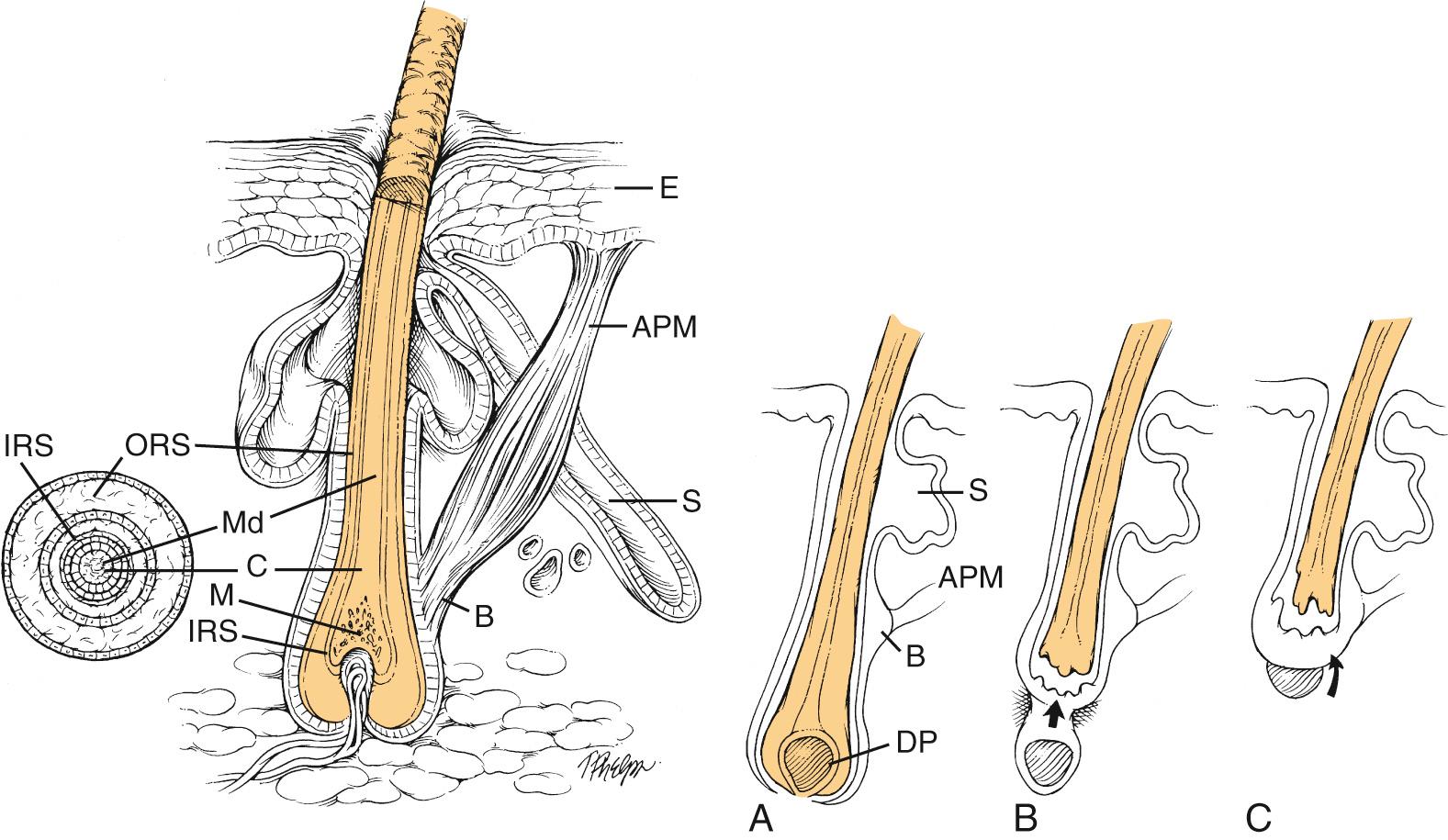
Hair development is a cyclical process that consists of four key phases: (1) anagen is a growth phase, (2) catagen is involution, (3) telogen is a rest phase, and (4) exogen is shedding. Approximately 90% of scalp hair follicles are in the anagen phase, a growth phase that lasts about 3 to 4 years for most humans. Following anagen, cellular proliferation ceases during a 2-week-long catagen phase, which leads to follicular involution. Approximately 1% of scalp hair follicles are in the catagen phase at any given time. Follicles in catagen transition into telogen, a 3- to 4-month dormancy phase characterized by no active hair growth. Telogen follicles comprise about 10% of the scalp's follicular population. Proteolytic enzymes induced during the telogen phase cause the hair shaft to be shed during exogen .
The hair cycle is an asynchronous process that leads to approximately 50 to 100 hairs being shed daily as follicles transition between rest and growth phases. Androgens play an essential role in regulating and influencing hair growth. At puberty, androgens increase the size of the follicles in the beard, chest, and extremities. With advancing age, they have the opposite effect and decrease the size of genetically predisposed scalp follicles.
The most common type of hair loss is androgenetic alopecia (AGA), also known as male pattern baldness (MPB). This form of alopecia affects scalp follicles with a genetic potential for androgen inhibition. In affected areas, genetically sensitive hair follicles exposed to normal levels of dihydrotestosterone (DHT) go through progressively shorter anagen growth phases. With advancing age, miniaturization causes susceptible terminal hairs to become shorter, finer, and lighter in color. Miniaturized hairs conceal the scalp less as they eventually progress to end-stage vellus hairs. The progression and extent of AGA are highly unpredictable. Miniaturization can advance rapidly, gradually, or intermittently with waves of advancement and dormancy. Inheritance is polygenic, and penetrance is variable, which, thus, limits the usefulness of family history for predicting pattern progression. In men, AGA is characterized by classic hereditary MPB, in which progressive miniaturization of the hair follicles appears most commonly in the frontotemporal and crown regions ( Fig. 22.2 ). In women, AGA typically manifests as a diffuse thinning of the central scalp with an intact anterior hairline ( Fig. 22.3 ), although occasionally a male-pattern type of hair loss can occur. AGA affects more than half of the male population and up to 40% of women older than 70 years.
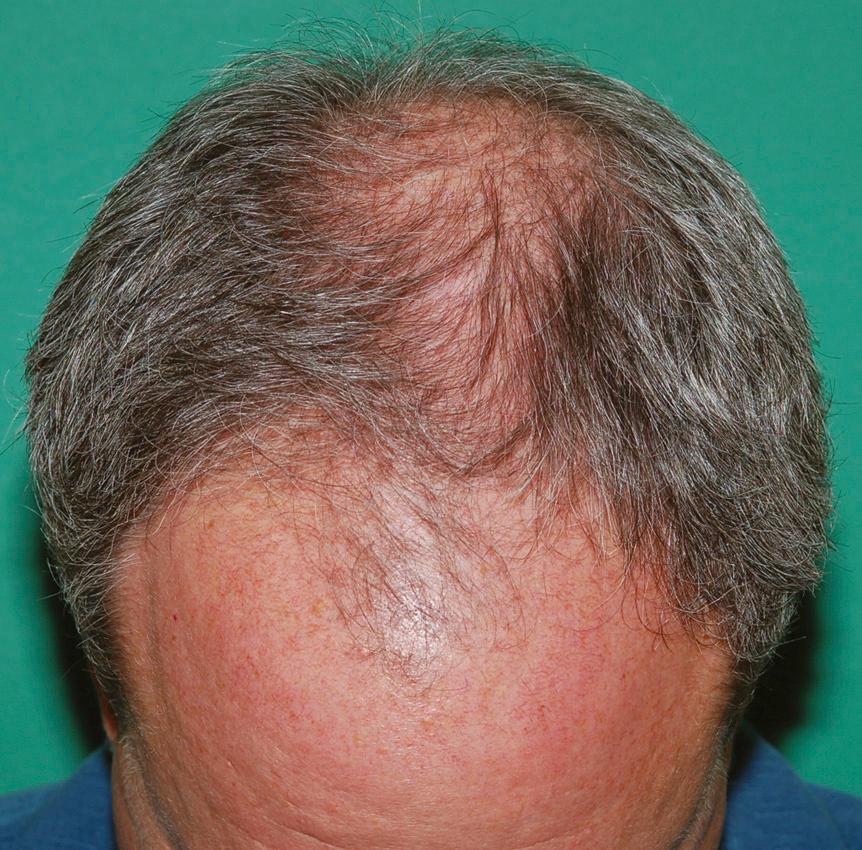
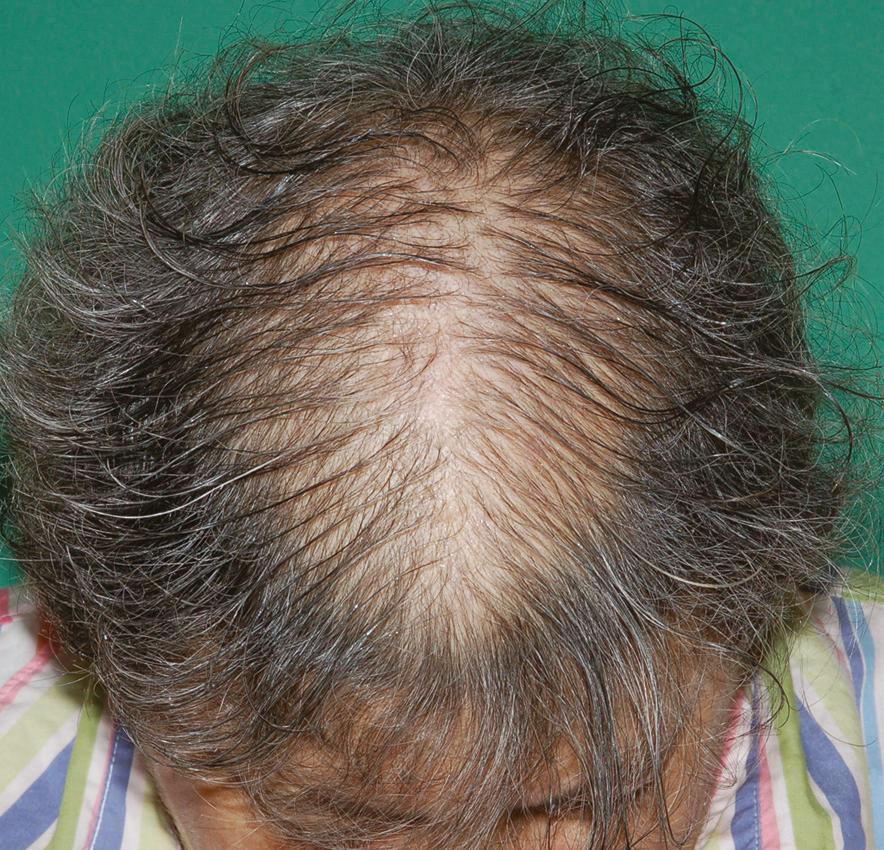
Although AGA is the most common cause of hair loss, other etiologies should be considered during the patient evaluation ( Box 22.1 ). Anemia, thyroid disorders, burns, traction, infections, autoimmune disease, neoplasms, radiation exposure, psychologic disorders, and chemotherapy are only a few of the many causes of hair loss in humans. Many forms of hair loss are not amenable to hair transplant surgery, particularly if their underlying etiology has an inflammatory or cicatricial (scarring) nature. These conditions may fool even the most experienced hair transplant surgeons by appearing consistent with AGA; however, when transplanted, they have the potential to not grow or to grow in the short term only to fall out in the long term.
Alopecia areata
Anagen effluvium
Androgenetic alopecia
Bacterial infection or folliculitis
Burns
Congenital hypotrichosis or atrichia
Dermatomyositis
Discoid lupus erythematosus
Drug-induced alopecia
Hair shaft abnormalities
Iron deficiency
Lichen planopilaris
Malnutrition
Neoplasms
Physiologic stress
Postmenopause
Postpartum
Psychologic stress
Radiation
Sarcoidosis
Scleroderma
Surgical scars
Syphilis
Telogen effluvium
Thyroid disorders
Tinea capitis
Traction alopecia
Trauma
Trichotillomania
Alopecia areata (AA) is an autoimmune form of hair loss in which the body's inflammatory T cells mistakenly attack the hair follicle. The mechanism of action appears to have both a genetic and an environmental etiology. It typically presents as smooth round or oval patches of hair loss that can occur anywhere on the scalp, beard area, or body. Terms used to classify this disorder are (1) alopecia areata, which refers to one or more localized patches of hair loss; (2) alopecia totalis, the complete loss of scalp hair; and (3) alopecia universalis, or total loss of body hair. A less common form is diffuse AA, or alopecia incognito, characterized by widespread and diffuse hair loss. Dermoscopy can assist in providing a diagnosis, but scalp biopsy is recommended for definitive diagnosis. Evidence of so-called exclamation-point hairs—short, broken hairs with proximal tapering—is the most specific dermatoscopic feature in AA. Treatment usually consists of high-potency topical steroids under occlusion. The results of hair transplantation for AA can be uncertain, and patients must accept the risk of a flare at any time that can affect transplanted hairs, hairs near the donor area, or other unrelated hairs.
Telogen effluvium is a diffuse hair-shedding process in which large numbers of hairs quickly shift from a growth phase to a resting phase. It is a physiologic response that can occur in association with major psychologic stress, hormonal or systemic conditions, general anesthesia, crash dieting, childbirth, high fever, a broad range of medications, and chronic illness. Telogen effluvium typically presents with rapid and diffuse hair loss 3 to 6 months following the stressor event. The process is usually self-limiting, and treatment is generally not required.
Diffuse hair loss can occur with hypothyroidism or hyperthyroidism, following childbirth, following menopause, and with a host of drugs that include chemotherapy agents, anticoagulants, anticonvulsants, thyroid hormone replacement drugs, β-blockers, tricyclic antidepressants, and oral contraceptives. Patients who are malnourished, specifically those with deficiencies in protein and essential minerals such as zinc and iron, may have poor hair growth and diffuse alopecia. Tinea capitis is a cutaneous fungal infection that can also present with diffuse hair loss. Diagnosis can be made with either scalp biopsy or scraping the affected area and staining with potassium hydroxide for fungus.
Cicatricial alopecias may be mistaken for AGA. These conditions can result in permanent hair loss from inflammation-based destruction of the pilosebaceous unit. Signs and symptoms of early-stage disease include itching, burning, diffuse hair loss, perifollicular erythema, and scaling. Progression of the disease leads to long-term cicatricial scarring characterized by shiny white skin with total loss of follicular openings ( Fig. 22.4 ). Transplantation of these conditions is risky because of the waxing and waning nature of the inflammatory infiltrate. Transplanted follicles may grow in the short run only to be lost months or years later with a recurrent flare of the condition. Some cases of cicatricial alopecia may be transplanted, but this should only be considered after 2 to 5 years of following the condition for complete stabilization without any evidence of active disease. Clues suggestive of inflammation or scarring require biopsy before considering surgical restoration.
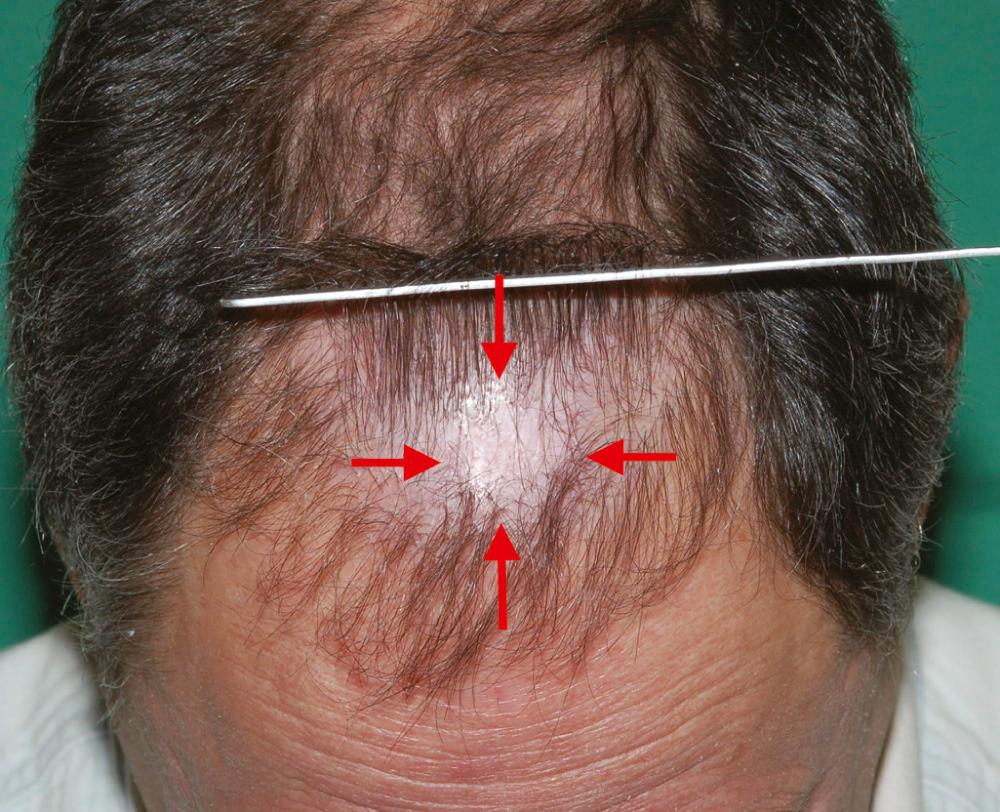
Cicatricial alopecias are traditionally classified by their inflammatory infiltrate, which may be lymphocytic, neutrophilic, or mixed. Scarring alopecias include lichen planopilaris, frontal fibrosing alopecia, pseudopelade of Brocq, discoid lupus erythematosus, and folliculitis decalvans. Histologically, folliculitis decalvans shows a neutrophilic infiltrate in and around hair follicles. Dermatoscopic examination usually reveals pustules, a golden crust, and tufting of hair follicles. The pustules can be sterile but are frequently colonized with Staphylococcus aureus . Treatment requires topical and oral antibiotics.
A classification system is necessary for planning and comparing the results of different surgical procedures. The Norwood classification system ( Fig. 22.5 ), the classification guide used most frequently for men, organizes MPB into seven categories that range from class I (minimal frontotemporal recession) to class VII (a very narrow, horseshoe-shaped band of hair in the temporal and low occipital regions). Female baldness patterns can be similar to those observed in men, but alopecia in women more often presents with complete to partial preservation of the anterior hairline and an oval-shaped area of diffuse thinning on top of the scalp. Although the Norwood classification system can be used for female patients with masculine patterns, the preferred system was described in 1977 by Ludwig , who classified thinning into three grades that range from grade I, or minimal hair loss, to grade III, or severe generalized thinning ( Fig. 22.6 ).
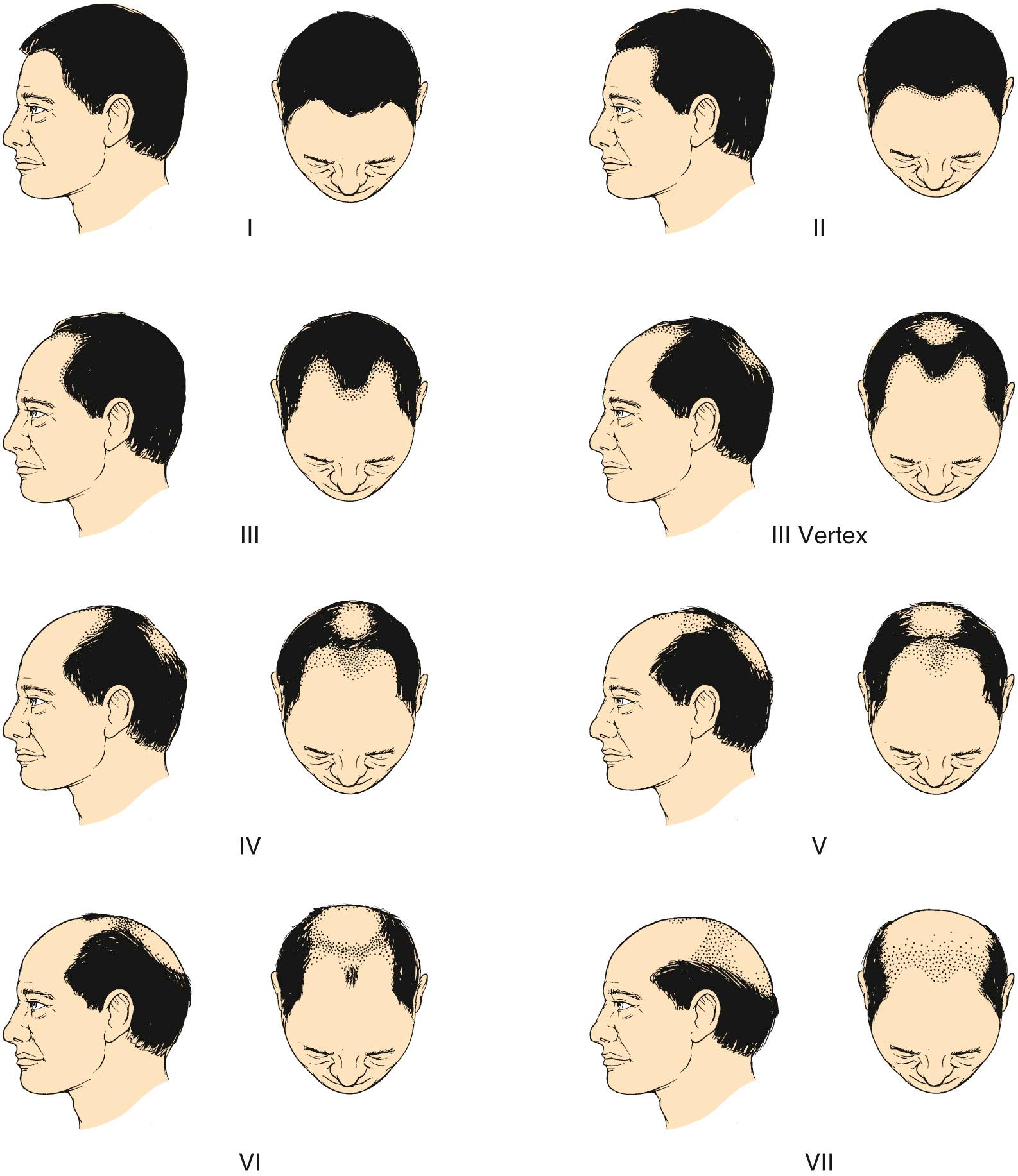
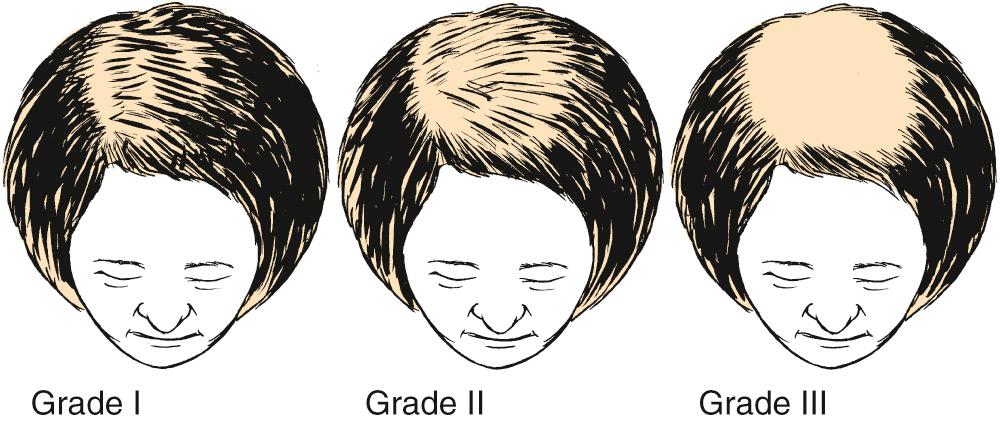
Attempts to medically manage MPB are nothing new. In about 400 bce , Hippocrates prescribed several concoctions composed of animal and plant products to treat baldness. Currently, the medical management of AGA is focused on topical products that help promote follicular growth and oral products directed against DHT, the active agent involved in promoting baldness.
Minoxidil (Rogaine) was the first drug approved by the U.S. Food and Drug Administration (FDA) for the medical management of MPB. Originally developed as an antihypertensive agent, it attracted interest for hair-loss therapy when patients who used this drug via the oral route were noted to develop generalized hypertrichosis. This observation led to its topical formulation, which has become a first-line treatment for men and women with pattern hair loss. Topically applied minoxidil is available as an over-the-counter preparation in either a 2% or 5% solution or as a 5% foam. Minoxidil does not have any known effect on the production, excretion, or interactions of human androgens. Its mechanism of action was originally thought to be secondary to vasodilation but more recently has been linked to the opening of potassium channels. Minoxidil was shown to increase follicle size and the percentage of anagen follicles in clinical studies of MPB. Topically applied minoxidil results in increased hair weight with a less dramatic increase in hair counts, suggesting that its therapeutic effect is primarily due to increased diameter of existing hairs. In MPB, the 5% concentration is superior in efficacy to 2%, with 45% more hair growth after 48 weeks of treatment. The most commonly observed side effect is allergic or irritant contact dermatitis predominantly to propylene glycol, which is used to improve minoxidil solubility in the liquid vehicle. Irritant contact dermatitis occurs less frequently with the 2% compared with the 5% solution, and patients who exhibit this type of reaction can be switched to the 5% foam vehicle, which is formulated without propylene glycol.
More recently, low-dose oral minoxidil has been used to treat various causes of hair loss (including androgenetic alopecia, alopecia areata, and chronic telogen effluvium) in patients who do not have noticeable results or who are intolerant to the topical formulation. Oral minoxidil is a potent arteriolar vasodilator, and it is important to discuss the potential cardiovascular side effects in detail with the patient prior to initiating treatment. Currently, there are no large studies regarding the dosage and safety of oral minoxidil for treating hair loss. Smaller studies examining oral minoxidil have demonstrated more rapid and extensive hair growth, compared to topical treatment, in patients with alopecia areata. A recent study examined the use of 0.25 mg oral minoxidil in combination with spironolactone in 100 women with androgenetic alopecia, and demonstrated a reduction of hair loss and hair shedding at 6 and 12 months. Another study examined 36 women with chronic telogen effluvium who were treated with oral minoxidil (range 0.25 mg to 2.5 mg) daily for 6 months. All the patients in the study demonstrated an improvement from baseline at either the 6-month or 12-month mark. The use of minoxidil tablets to promote hair growth is currently not an FDA-approved indication and is prescribed off-label.
Finasteride (Propecia), which has been used for years to manage prostate hypertrophy, was approved by the FDA for the treatment of MPB in 1997. It is a type II 5α-reductase inhibitor that decreases serum and scalp levels of DHT. Finasteride is administered orally at a dose of 1 mg daily and is the most effective FDA-approved treatment for male pattern hair loss. It acts predominantly by increasing hair diameter and growth rate, although increased hair counts are also observed to a lesser degree. Daily treatment with 1 mg finasteride resulted in stabilization of pattern hair loss in 51% of patients and regrowth in 48%. The first signs of efficacy are usually seen at 3 months, when men who complain of increased hair shedding during their hair-loss process begin to notice less shedding. One year of therapy is required to fully assess stabilization and/or regrowth. The most common drug-related side effects are decreased libido (1.9%), erectile dysfunction (1.4%), and decreased ejaculate volume (1.0%). Resolution of these side effects occurred in those who discontinued the drug. Other side effects reported include breast tenderness, breast enlargement, breast nodules, depression, allergic reactions, testicular pain, and rare cases of male breast cancer. A small number of men claim to have suffered permanent sexual dysfunction despite discontinuation of the drug ; however, the majority of studies do not support these claims. Men over the age of 45 years should be advised that finasteride affects the results of prostate-specific antigen tests, and they should, therefore, report the use of this medication to their physician. Women should not handle crushed or broken finasteride tablets when pregnant or trying to become pregnant because of the possibility of percutaneous absorption and subsequent risk to the male fetus.
Light was first reported to stimulate hair growth in 1967 in a mouse model. Reports of paradoxical hair growth in patients who received laser therapy for hair removal prompted evaluation of this modality in treating patients with AGA. The mechanism of action for hair stimulation is presumed to be mediated by absorption of photons by cytochrome oxidase in the mitochondrial respiratory chain, which results in increased oxygen consumption and adenosine triphosphate production. Gene regulation that results in decreased apoptosis is presumed to occur as a result. Several devices are available for patient use, which generate a wavelength of 630 to 680 nm. The optimal frequency, power, and duration for treating pattern hair loss with low-level light and laser therapy have yet to be determined.
Become a Clinical Tree membership for Full access and enjoy Unlimited articles
If you are a member. Log in here